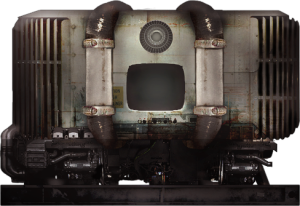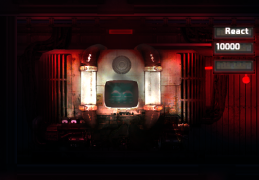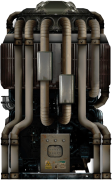Nuclear Reactor

|
Data is potentially outdated |
| Last updated for version 0.10.5.1 Last mentioned in changelog 1.1.18.0 The current game version is 1.4.4.1 |
| Nuclear Reactor | ||||||||
|---|---|---|---|---|---|---|---|---|

| ||||||||
| Statistics* | ||||||||
| Item Slots | 4 Fuel Rod slots | |||||||
| ||||||||
The nuclear reactor is the most crucial installation found in Barotrauma. It acts as the submarine's main power source for all installations.
Function
The nuclear reactor's function is to generate power for other installations on the submarine. As long as the reactor is active, every other connected device on the ship will remain active as well. Power generated by the reactor is sent to other installations via wiring. Power distribution requires Junction Boxes to work, as the reactor cannot send power to other installations directly. Maintaining the power network is one of the most important aspects of a round, as the submarine cannot function without power.
The nuclear reactor undergoes a process called nuclear fission, in which atoms are split apart, cause large amounts of energy to be released. The rate at which these reactions take place is measured by the fission rate. The resulting reaction also causes heat to be released that raises the overall temperature of the reactor. If the temperature raises past 6,000 degrees for too long, the reactor will catch on Fire. If the temperature stays over 6000 degrees for too long, it will meltdown, creating a massive radioactive explosion. It is possible to fix the submarine and reactor after a meltdown, but it is difficult due to radiation and lack of power and, often, walls. Because of this, the cooling and fission rates must be adjusted to keep the temperature at a desired level - which is usually the same as the amount of power consumed by the electrical grid of the submarine.
Fuel Rods are required for the nuclear reactor to function. The reactor can hold up to four rods. They will be slowly consumed at a rate proportionate to the Fission Rate. Fuel Rods can be removed and replaced at any time.
If the reactor is in water, it will take damage over time, down to 10% condition.
Even when not in water, a reactor will slowly deteriorate over time, requiring maintenance. A reactor will not deteriorate below 10% condition.
If the reactor reaches 0% condition, it will instantly meltdown.
Usage

When a reactor is selected, a control panel opens up. The panel displays two gauges, a bar graph, and a line graph. They represent the fission rate, turbine output, temperature, and reactor load/output respectively.
In this control panel, players can manually set the fission rate and turbine output of the reactor or toggle automatic control.
Manual Control
Under manual control, the Fission and Turbine are controlled manually. A player should be stationed near the reactor to adjust the fission and turbine appropriately for the ship's fluctuating power requirements. Manual control can respond to power fluctuations faster than Automatic mode, but requires player attention.
- Start the reactor using the button on the top-right labelled "Power". The light next to the button should glow.
- Ensure automatic control is off. The light next to the switch should be off.
- The sliders beneath Turbine Output and Fission Rate are now grabbable.
Automatic Control
Automatic Control controls the Fission and Turbine automatically. It reacts to changes in load slower than a human can, but requires little player attention.
- Start the reactor using the button on the top-right labelled "Power". The light next to the button should glow.
- Turn on automatic control using the switch on the top-right labelled "Automatic Control". The light next to the switch should be on.
- The reactor will slowly adjust Turbine Output towards the load and Fission Rate towards the middle temperature (5000).
Wire Control
Wire control controls the Fission and Turbine remotely through Wiring Components. Wire control overrides both Automatic and Manual controls. It can also be used to warn about overheating, meltdowns, and used to remotely shut down the reactor.
Fuel Rods
| Fuel Rod Type | Durability | Heating Power | Mechanical Skill to Craft | Crafting Materials | Crafting Time | Store Price |
|---|---|---|---|---|---|---|
 Uranium Fuel Rod |
100 | 80 | 25 | 10 | 135-150 Marks | |
 Thorium Fuel Rod |
200 | 100 | 60 | 10 | 225 Marks | |
 Fulgurium Fuel Rod |
150 | 150 | 40 | 10 | Not purchasable |
Meltdown
When a reactor reaches 0% condition, it will meltdown, generating a large radioactive explosion. Any fuel rods in the reactor will be completely exhausted.
| Item |
Afflictions on Hit |
Structure Damage |
Kinetic Force |
Explosion Radius (m) |
|---|---|---|---|---|
| 100 |
5.0 |
8.0 | ||
| 100 |
5.0 |
20.0 |
Connection Panel
| Connection Panel for Nuclear Reactor Hover over pins to see their descriptions. | ||||||||||||||||||||||||||||||||||||||||||||||||||||||||||||||||
|---|---|---|---|---|---|---|---|---|---|---|---|---|---|---|---|---|---|---|---|---|---|---|---|---|---|---|---|---|---|---|---|---|---|---|---|---|---|---|---|---|---|---|---|---|---|---|---|---|---|---|---|---|---|---|---|---|---|---|---|---|---|---|---|---|
| ||||||||||||||||||||||||||||||||||||||||||||||||||||||||||||||||
| Requires: | ||||||||||||||||||||||||||||||||||||||||||||||||||||||||||||||||
Default Submarine Max Power Output
| Submarine | Max Output |
|---|---|
| Azimuth | 10,000 |
| Berilia | 6,500 |
| Dugong | 2,700 |
| Humpback | 2800 |
| Kastrull | 10,000 |
| Orca | 3,500 |
| R-29 | 5,200 |
| Remora | 5,000 |
| Typhon | 5,000 |
| Typhon 2 | 5,000 |
Audio
-
Reactor active ambience
-
Reactor overheat alarm
Gallery
-
A Nuclear Reactor during a meltdown.
-
A Nuclear Reactor on fire.
-
A Nuclear Reactor used in outposts.
| Installations | |
|---|---|
| Submarine Weapons | |
Small Turrets
|
Large Turrets
|
Loaders
| |
Other
| |
| Navigation | |
| Machines | |
| Electrical | |
| Structure | |
| Other | |
| Alien | |








